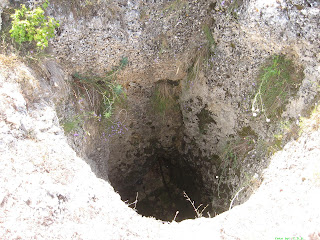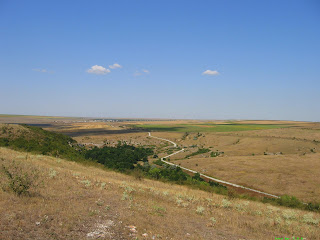I've presented so far most of the main touristic attractions (at least from my point of view) from the Romanian part of Dobrogea, especially those that I consider to be less publicized. But there is still much to be seen, admired or discovered. I hope to update some of the posts with new photos (if I ever get to those places) and hopefully add more interesting (or mainly photo) posts regarding the bigger cities (Tomis/Constanţa crosses my mind now).
Regarding the archaeological heritage, almost every place has its own story, sometimes still buried deep underground, sometimes lost for good, but I think I've covered most of the ones still seen today. The Romanian Mapserver for National Cultural Heritage is the main reference regarding archaeological findings and sites in the area.
Although Dobrogea means first of all history, it's also a place were one can find welcoming people, peaceful places in the middle of the nature and wonderful landscapes (and also modern attractions if you look for them in the cities)
These being said, here's a list of other interesting places worth seeing on the todays Romanian territory of Dobrogea and some links at the end:
- Proslaviţa Fortress - (Nufăru village) is situated 12 km from Tulcea, on the right bank of the Sfântu Gheorghe channel. The fortress was built in an area with traces of the Hallstatt, Latene and Roman-Byzantine periods. During the Roman-Byzantine age, there were two surveillance towers on the right bank of the Danube. Archaeological diggings led to the discovery of an inside wall and of two massive towers. The fortress functioned until the 14th century.
- The Dobrogea Gorges - Splendid landscape with limestone walls (see below), some 40m high, placed in the proximity of the road, about 45 Km from Constanţa city, between Târguşor and Cheia. The gorges are natural reservation. They were once coral reefs on the bottom of the sea. More info here and the location on Google Maps.
- The Caves of Gura Dobrogei - situated nearby the Dobrogea Gorges, are part of a complex reservation (spelaeological, paleontological, geological, faunistic). The caves are small, and rather hard to find. Some of the more important caves are:
- La Adam (Adam's Cave) - where was discovered a sanctuary of the god Mithras (1st-2nd centuries AD.)
- Bat's Cave (Peştera Liliecilor) - where were found some tools from the Lower Paleolithic and nowadays hosts colonies of bats
- St. John Cassian Cave (Peştera Sf. Ioan Casian) - where lived the saint John Cassian, who is celebrates by the Orthodox Church on the 28th of February.
The location on Wikimapia and some personal photos of the surroundings (unfortunately I missed the caves).
- Movile Cave - unique karst cave situated near Mangalia and the Black Sea shore.
- Beautiful and peaceful monasteries:
- Beautiful and peaceful monasteries:
- Techirghiol Monastery - located here
- Saon Monastery - located here
- The Monastery of Uspeni - located here
- The Monastery of Vovidenia - located on the southeastern outskirts of the Slava Rusă village.
- and other smaller ones, usually placed in remote locations
- Many natural reservations protected by law (around 38 in Constanța county and another 34 in Tulcea), but pay attention when traveling that you might not notice that you've entered a natural reservation:
- The Danube Delta - the most important of all (hope to getting there sometime and dedicate a post for it)
- Măcin Mountains National Park - the highest mountains in Dobrogea
- Techirghiol Lake – the largest saline lake in Romania, with a surface of 10,7 square km hosts a specific microfauna
- Cheia Massive – situated on the left border of Casimcea Valey, it is sheltering approximately 565 rare specie of flowers
- Agigea Dunes – about 120 species of rare plants
- Hagieni Forest - hosts rare species of plants and animals
- Babadag Forest - mixed reservation
- Fântâniţa-Murfatlar reservation - rare species of plants and the Dobrogea turtle
- "Canarelele Harşova" - Jurassic limestone containing coral fossils and not only
- Fossiliferous Point of Aliman - situated near the Aliman commune in the Urluia Valley, the reservation contains the lakes Sarpul and Vederoasa
- Fossiliferous Point of Seimenii Mari - contains about 60 species of fossils
- Fossiliferous Point of Cernavodă - contains a fossil fauna of 72 species
- Fossiliferous Point of Agighiol - rich Medium Triassic (Muschelkalk) fauna
- Topalu NeoJurassic Reef – is situated between Cernavodă and Hârşova, hosting a Jurassic limestone complex containing corals, worms and sponges
- Esechioi Forest - botanical and zoological reservation
- Canaraua Fetii Forest - botanical and zoological reservation
- Dumbrăveni Forest - botanical and zoological reservation
- The Limestone Walls of Petroşani
- The Fossil Lake "Credinţa"
- Alan Bair Hill
-Dobrogea landscapes - peaceful and colorful places (some photos below):
(although it is said that the sunflower faces the sun, these ones were facing the other way, just to mess with my photos I guess :D )
Here's also some other links regarding Dobrogea (some of them also mentioned in the "intro" post):
- Dobrogea - The Land between Water and Sun - Youtube videos
- Beautiful Dobrogea - photo blog
- Discover Constanta County - forum thread
- Xplorio - photo blog (posts in Romanian)
- Măcin Mountains (Alpinet.org) - article with photos (in Romanian)
- RestRomania - travel guide
- Dobrogea photos - Picassa Web Album
- XmeTi - archaeology site
- Map of Constanţa county - an interesting interactive map of this part of Dobrogea














No comments:
Post a Comment